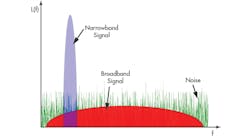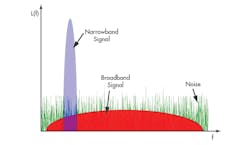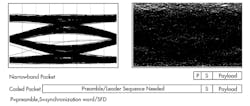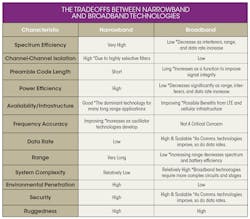What’s the Difference Between Broadband and Narrowband RF Communications?
Download this article in .PDF format
Although the wired-internet communications industry is currently at the center of the broadband-versus-narrowband debate, similar discussions are happening in the RF communications industry. Increased data rates—the obvious benefit of broadband communications—are enticing investments in broadband technologies. For the wired-internet communication industry, the chief challenges being faced are laying broadband-capable data pipes and switching networks.
Outside of that industry, however, there are many more physical factors that limit the implementation of broadband systems. These issues are prompting the debate over narrowband or broadband solutions. This discussion takes into account both applications and customer requirements, as many of these applications require military/public-safety-grade reliability and performance over impressive ranges.
At the center of this debate is broadband communications (also sometimes referred to as wideband). This term generally applies to the use of frequency ranges beyond those used by narrowband communications. For its part, narrowband refers to communications that use frequency content within the coherence band of a frequency channel. Generally, it refers to frequency operation that is narrower than broadband. Of course, these definitions somewhat depend upon applications as well. As a result, it is easier to focus on particular technological solutions and the physical behavior behind the different approaches (Fig. 1).
All applications share a set of most-desired parameters: communications that have the highest data rate, use the least spectrum, consume the least amount of power, have the longest range, and are the most resistant to interference. To ensure a high data rate, however, the frequency spectrum used must be increased. This step invariably lowers the power, range, and resistance to interference.
These tradeoffs comprise the critical differences between broadband and narrowband RF communications. For most applications requiring long-range, low-power, and reliable communications, narrowband tends to be the dominant choice. If high data rates are necessary, techniques like cellularization, coding gain, and others are used to mitigate the decreased range and resistance to interference. But this is done at the cost of power.
According to Bruce Collins, product manager for Cambium Networks, “In narrowband solutions (channels below 500 kHz), the smaller channel bandwidths have lower thermal noise. So in order to achieve a similar signal-to-noise ratio, a lower receive level is needed. Thus, a lower transmit power is required. This lower transmit power leads to reduced power consumption, enabling solar-powered solutions and/or extremely long battery life.
“Additionally, the lower frequency bands used by narrowband systems (sub-1-GHz) propagate much further, due to physics,” he continues. “Again, this reduces power requirements for the same distance or increases the range for the same power consumption.”
Regarding power-conscious applications, which often require battery power or the low-power necessities of wireless-sensor-nodes (WSNs), Collins notes, “Narrowband provides better distances per watt of power consumption than broadband. This is critical from the remote node, but less so for the access point or hub location.” These factors are particularly relevant for public-safety voice applications, alarm systems, critical distributed sensors, and vital machine-to-machine (M2M) communications.
In large oil fields, for example, the automated protection systems require low-data-rate and long-range reliable communications of the flow sensors at oil pumps. These pumps can be many miles apart and even beyond line-of-site trajectories of each other. A broadband system would most likely cost significantly more to implement in this scenario. It also could require many repeaters/cells to ensure the necessary reliability.
Conversely, if the application required video streaming or other sensor systems that produce massive amounts of data, there would be little recourse beyond a broadband system. “The lower power consumption of narrowband systems will also lead to a lower cost for remote applications,” Collins says. “Cost is a premium at the remote site.” These cost factors are key to the debate between the two technologies.
According to Mark Faulkner, vice president of RF Integrated Solutions Engineering at Microsemi, “There is a fundamental gain-bandwidth transistor-matching tradeoff. Transistors can be matched to optimize their highest gain, power, or efficiency performance over a narrow bandwidth. A broadband transistor match yields less gain per stage, which requires more amplifier stages to achieve the equivalent overall performance.”
As circuit complexity increases, design time rises and yields often decrease. “The addition of extra stages for the broadband amplifier draws more current and reduces efficiency,” says Faulkner. “In addition, broadband-transistor matching networks contain a higher number of reactive elements, which add losses that become significant at millimeter-wave frequencies.”
Many applications—such as military radios, smart metering, oil/gas monitoring, and public safety—have historically used narrowband communications for their increased range and reliability. With the growing demand for advanced surveillance and more data-heavy applications like video streaming, however, public-safety and other industries are looking into the benefits of broadband technologies.
Yet their needs are directly at odds with the shortage of available spectrum and the FCC’s narrowbanding policies. As of January 1, 2013, all business-industrial and public-safety bands from 150 to 512 MHz were shrunk from 25 to 12.5 kHz in an effort to reduce spectrum—an approach called narrowbanding (Fig. 2).
Undaunted by these challenges, discussions continue to focus on the implementation of broadband systems for public-safety and even military networks. For example, there is an increasing call for public-safety officers to be able to stream live videos of their responses to criminal activity and investigations. In addition, emergency-medical military responders need to be equipped with high-data connections in order to stream real-time medical procedures and provide direction. These applications require significant amounts of data. Custom implementations could easily climb beyond the budgets of military and public-safety organizations.
A proposed solution to these cost troubles is to use commercial-off-the-shelf (COTS) technology, such as 3G and 4G/LTE data systems. Using these common backbones would ensure that public-safety, business-industrial, and military technologies could readily operate despite shifting FCC standards. The challenge then becomes securing these networks, although many sophisticated software- and hardware-based solutions are designed to security specifications.
Another challenge is sufficient infrastructure for these communications. Supporting such high-speed data may not be a significant challenge for stable urban environments. For military applications, though, there is the added concern of deploying stable, and often mobile, cellular networks (Fig. 3).
The IoT Angle
IoT/IoE applications are unique in that they call for millions of interactions for low-power sensors, which will be distributed throughout the environment. Those sensors will need to be developed alongside data-hungry machines with extremely fast data pipes. Complicating these debates is the existence of a seemingly endless amount of machines that are expected to soon become connected, requiring both high data rates and low power/reliability. This trend, known by buzzwords like the “Internet of Things (IoT)” and “Internet of Everything (IoE),” is encouraging developments and planning that are weighing the benefits of narrowband versus broadband solutions.
“With IoT/IoE applications, there will really be an explosion of volume with low-data-rate devices,” notes Collins. “These devices need less power and don’t even need a constant connection. Some data may need to be pulled or it may need to send small amounts of information, which means narrowband.”
Keep in mind that not all IoT/IoE applications will just be machine-to-machine remote data reporters. As Collins points out, “The other end of that is a destination security video camera, which would require broadband data rates. It is an interesting discussion, as it combines two opposite ends of the spectrum. Certainly, IoT is very important to narrowband, if you are just controlling a thermostat or flipping a switch.”
Invariably, many of the latest applications will need both narrowband and broadband systems. The question is how to merge the two technologies on a standards and device-infrastructure backbone. With a sufficiently expansive cellular infrastructure, the data backplane could be used to carry both high-data-rate applications and many low-data-rate applications from low-power (albeit plentiful) sources.
“Many application operators will likely go with configurable hybrid systems, which combine the best aspects of narrowband solutions for long range and lower power and broadband solutions for high-capacity video surveillance and remote-office applications,” says Collins. “From one standpoint, the networks will be hybrid—narrowband plus broadband, still based on a common IP backhaul utilizing a common management infrastructure and secure access.
“This ideal system-level solution requires common tools for narrowband and broadband using standard information-technology (IT) approaches,” he concludes.




